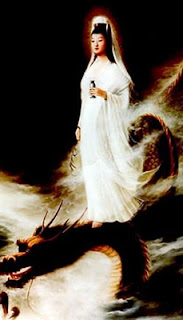


The willow branch is also a symbol of being able to bend (or adapt) but not break. In the right hand is a water jar (as the Sacred Vase the water jar also one of the Eight Buddhist Symbols of good Fortune) containing pure water, the divine nectar of life, compassion and wisdom, and in the left, a willow branch to sprinkle the divine nectar of life upon the devotees as to bless them with physical and spiritual peace. Guan Yin is usually shown in a white flowing robe - white being the symbol of purity -, and usually wearing necklaces of Indian/Chinese royalty. In Sanskrit she's known as Padma pani - "Born of the Lotus", the lotus symbolizing purity, peace and harmony.Īnother version suggests she originated from the Taoist Immortal Ci Hang Zhen Ren, (Chinese: 慈航真人 pinyin: Cíháng Zhēnrén literally "Compassion Travel/Navigate True Person"), a Taoistic ‘perfect person’ having an endless willingness and sparing no effort in helping those in need.Ĭommonly known in the West as the Goddess of Mercy, Guan Yin is also revered by both the Taoists and Buddhists. Image of Guan Yin sitting on a lotus, a willow branch and a water jar In the modern period, Guan Yin is most often represented as a beautiful, white-robed woman, a depiction which derives from the earlier Pandaravasini form. The twelfth-century legend of the Buddhist saint Miao Shan (see below), the Chinese princess who lived in about 700 B.C., is widely believed to have been Kuan Yin, reinforced the image of the Bodhisattva as a female. The representation in China was further interpreted in an all-female form around the 12th century, during the Ming Dynasty (1368- 1644 AD). In Mahayana Buddhism, to which Chinese Buddhism belongs, gender is no obstacle to Enlightenment.Īs the Lotus Sutra relates, the Bodhisattva Kuan Shih Yin, "by resort to a variety of shapes, travels in the world, conveying the beings to salvation." Later images might show female and male attributes, since a Bodhisattva, in accordance with the Lotus Sutra, has the magical power to transform the body in any form required to relieve suffering, so that Guan Yin is neither woman nor man. It is generally accepted that Guan Yin originated as the Sanskrit Avalokitesvara, which is her male form, since all representations of Bodhisattva were masculine. Representations of the Bodhisattva in China prior to the Song Dynasty (960-1279 AD, Northern - and Southern Song Dynasty) were masculine in appearance. Some Taoist scriptures give her the title of Guan Yin Da Shi, and sometimes informally as Guan Yin Fo Zu.Īlong with Buddhism, Guan Yin's veneration was introduced into China as early as the 1st century AD, and reached Japan by way of Korea soon after Buddhism was first introduced into the country from the mid-7th century. The Chinese translation of many Buddhist sutras has in fact replaced the Chinese transliteration of Avalokitesvara with Guan Shi Yin. (Bodhisattva- being of bodhi or enlightenment, one who has earned to leave the world of suffering and is destined to become a Buddha, but has forgone the bliss of nirvana with a vow to save all children of god.Īvalojkitesvara (Sanskrit: अवलोकितेश्वर): The word ‘avalokita’ means "seeing or gazing down" and ‘Êvara’ means "lord" in Sanskrit).Īmong the Chinese, Avalokitesvara is almost exclusively called Guan Shi Yin Pu Sa. In Chinese Buddhism, Guan Yin is synonymous with the Bodhisattva Avalokitesvara, the pinnacle of mercy, compassion, kindness and love. Thailand: Kuan Eim (กวนอิม) or Prah Mae Kuan Eim Japan: Kannon or more formally Kanzeon the spelling Kwannon, based on a pre-modern pronunciation, is sometimes seen Highly respected in Asian cultures, Guan Yim bears different names as follows: The name Guan Yin also spelt Guan Yim, Kuan Yim, Kwan Im, or Kuan Yin, is a short form for Kuan-shi Yin, meaning "Observing the Sounds (or Cries) of the (human) World".
#Namo kuan shi yin pusa full
_ Guan Yin, Guan Yim, Kuan Yim, Kuan Yin Guan Yin (in Chinese: 觀音, pinyin guānyīn full name: 觀世音 Guan Shi Yin in Thai: กวนอิม)Ĭhinese Bodhisattva/ Goddess of Compassion, Mercy and Kindness is considered to be a mother-goddess and patron of seamen.

Home Earth Continents Asia Thailand / China Chinese New Year Photos Chinese Customs and Traditions Glossary Guan Yin


 0 kommentar(er)
0 kommentar(er)
